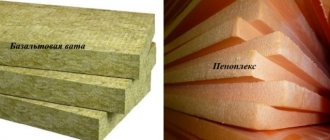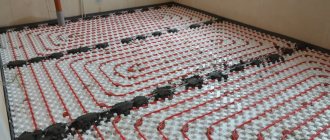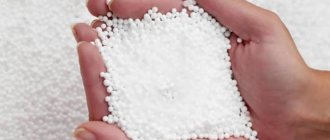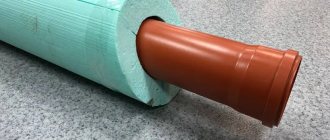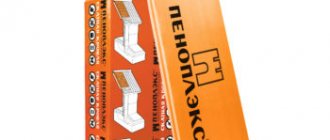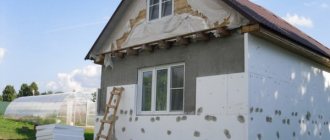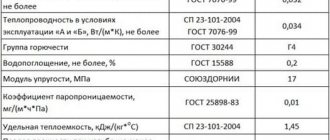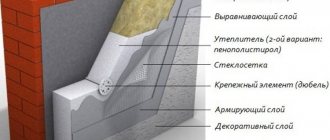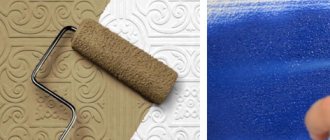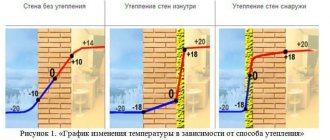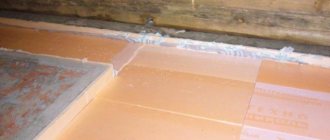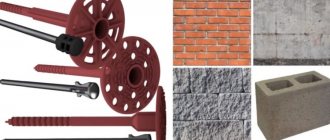Extruded polystyrene foam is a modern thermal insulation material, which literally in recent years has gained strong confidence in itself and is in great demand in construction work.
Externally, this material has a homogeneous structure, which consists of porous cells measuring 0.1-0.2 mm. Making polystyrene foam involves mixing polystyrene granules at high temperatures and pressure and then extruding the component from an extruder.
Scope of use of extruded polystyrene foam
This material is used in industrial and private construction. It is a universal material that can be used for thermal insulation:
- Sexes;
- Roofs;
- Sten;
- Foundations;
- Facades;
- Partitions;
- Warm floors.
Criteria for choosing expanded polystyrene
The purchase of expanded polystyrene should contribute to the maximum service life of the thermal insulation coating.
Incorrect determination of thickness is a major mistake that can lead to reduced service life of the material. Too thin insulation will cause significant heat loss in the house. The characteristics and structure of expanded polystyrene do not allow the use of too thick material. As a result of temperature changes, such insulation will crack or become covered with “waves”, through which cold air from the street will flow.
When purchasing insulation, first pay attention to its labeling. PSB-S-40 polystyrene foam, which is a self-extinguishing product, is suitable for façade thermal insulation work.
The number “40” indicates the density of the material, which is 40 kg / 1 m³. But the sold polystyrene foam PSB-S-40 does not always have such a density. To ensure the excellent quality of the insulation, it is necessary to carefully inspect it.
To do this, a small piece of the product is broken off. The formation of an uneven edge with small round balls as a result of the fracture of polystyrene foam indicates poor quality of the material. The good quality of the product will be indicated by the presence of regular polyhedra at the fault site, through which the fault line will pass.
When choosing the right polystyrene foam, we pay attention to four main characteristics:
-structure of the material;
-compressive strength;
-water absorption;
-thermal insulation properties.
The structure of the insulation must be uniform and fine-celled. When the cells are clearly visible or the structure of the material is highly porous, then polystyrene foam is not a product of the highest quality.
Compressive strength is checked by pressing on the insulation. If expanded polystyrene “makes” a crackling sound, then such a material (with thin walls and large cells) is unsuitable for high-quality thermal insulation work. High-quality insulation can withstand loads of up to 60 t/m².
The level of water absorption of polystyrene foam can also be checked in a practical way. For comparison, two pieces are cut from the two types of insulation and placed in water for a day. After 24 hours, the samples are laid out on a napkin. After pressing, more water will be squeezed out of poor quality material.
Thermal insulation properties are evidenced by the thermal conductivity of the material. This indicator is determined in laboratory conditions using special equipment. Maximum thermal insulation qualities are achieved only if the work technology is followed. It is mandatory to protect polystyrene foam from exposure to sunlight. To do this, use a cement-based plaster mortar.
The best manufacturers of expanded polystyrene are European ones, Polimeri Europa and BASF. .
Video about choosing expanded polystyrene granules:
Thermal insulation of floor coverings
Thermal insulation of floors is a very important point when building a house. In addition to maintaining heat in the room, the heat insulator maintains constant humidity in the room. It also protects against the penetration of moisture into the building from the soil.
Thermal insulation with extruded polystyrene foam guarantees good results in the fight against low temperatures and moisture. The treated floor is even very pleasant to the touch.
How to choose high-quality polystyrene foam insulation yourself?
There is no problem in this regard. The construction market offers a relatively small range of insulation materials of different densities. Depending on the planned loads, preference is given to polystyrene foam panels of the PSB-S-15, PSB-S-25 and PSB-S-35 brands, with a thickness of 30 to 100 mm.
Fastening the insulation using a disc dowel
- In temperate climates, optimal heat retention of walls and ceilings will be ensured by 40mm thick panels. In the northern regions this figure is 60mm. High-quality insulation made from primary raw materials is characterized by a homogeneous structure without foreign inclusions.
- Unlike polystyrene foam, extruded polystyrene foam can have a blue, yellow or other tint. This is how manufacturers highlight their products in the general assortment. The color of the panels does not affect the quality and durability of the material.
- New models of expanded polystyrene contain fire-retardant flame retardant components that resist flame formation very well.
When installing the best insulation for a polystyrene foam facade, in addition to adhesive fixation, disc-shaped dowel fasteners are used.
The length of the dowels is determined by the thickness of the insulation; the product is driven or wrapped into the concrete base no more than 30 mm. For porous foam or aerated concrete, this figure increases to 60 mm. Failure to comply with this requirement may initiate the formation of cold bridges.
Order insulation of your home with expanded polystyrene from our company today!
Insulation of walls inside a building
It is very important that the vapor and air permeability of the walls of the house are at the proper level. The walls must retain heat well and remove excess moisture outside the structure. This is why partitions are best made of wood.
However, the use of dense insulation, which prevents the removal of moisture, leads to the creation of condensation on the surfaces of walls or ceilings. Naturally, it is very uncomfortable to live in such rooms. Moisture leads to the development of mold and mildew, as well as pathogenic bacteria. The furniture will begin to deteriorate, as will the finishing materials.
Extruded polystyrene foam boasts excellent thermal insulation characteristics; it easily allows moisture to pass from the room to the outside. Walls insulated in this way are the best option for creating an optimal microclimate in the room.
Advantages and disadvantages
If you pick up this insulation, it becomes clear that its physical properties are somewhat similar to plastic. But still it has slightly different characteristics. It is denser and lighter, but still essentially remains the same plastic we know.
Pros of EPPS:
- Resistance to fungi. Fungi are a problem for many houses, especially country houses. However, given that extruded polystyrene foam is a synthetic material, fungi do not feed on it.
- Resistant to rotting. Again, due to the fact that this product is an artificial and not a biological material, it is not subject to decomposition and rotting.
- Frost resistance. This insulation can withstand even very low temperatures. The thing is that there is no moisture in it at all, so it does not freeze through.
- Low thermal conductivity. Considering that air is the best heat insulator, and there is no air in EPS, this is the main factor due to which the insulation does not conduct heat.
- Compression resistance. This material can withstand even very heavy loads.
But, like any other material, EPS is not without its drawbacks :
- Poor sound insulation.
- Weak resistance to ultraviolet radiation.
- A little environmentally friendly.
Despite some disadvantages, most developers and owners of private houses prefer to buy extruded polystyrene foam Compared to other types of insulation, the price-quality ratio of EPS is one of the best.
Roof insulation
Extruded polystyrene does not contain or accumulate moisture, which allows it to be used in any type of roof. This method of insulation has become widespread in apartment buildings.
Installation of polystyrene boards depends on the type of main roof of the building:
- Warm roofs - insulation boards are laid directly on the roofing material. The thickness of the slabs is about 7 mm;
- Cold roofs - installation of slabs is carried out leaving a gap to prevent moisture from entering, as well as for the purpose of ventilation of the roof.
When insulating attic spaces, polystyrene boards are laid between the rafters. In this case, a space equal to the width of the beams (rafters) of the house floor is filled.
Types of polystyrene foam for home insulation
To understand what kind of polystyrene foam is needed for specific types of work, it is worth carefully studying the types of material. Classification of heat insulators for walls and floors of a house is carried out according to the following criteria:
- raw materials for manufacturing;
- density;
- sizes.
Depending on the raw materials used, there are such types of foam as polyurethane, polyvinyl chloride (PVC) and polyethylene. The first has high elasticity and is a foam rubber that is actively used in the furniture industry. In construction, polyurethane foam is made from such foam.
Related article: Attaching a water heater to a wooden wall
Polyethylene foam is produced in the form of sheets and is used for packaging fragile items. The usual construction foam is PVC. Expanded polystyrene of this type is suitable as insulation for a house inside and out.
The density of the foam is an important indicator. The area of use of the material depends on it (whether it can be used in the construction of walls, floors, foundations, etc.). Before buying foam insulation for your home, it is better to familiarize yourself with what it is, depending on the feature in question:
- PSB 50 is a high-density material. It is rarely found in construction due to the desire of customers to reduce financial costs. This material is suitable as insulation from the outside and from the inside. Such material can be laid as part of the floor of premises with constant occupancy of people, furniture and equipment.
- PSB 35 is suitable for insulating the walls of a house from the outside and inside. This type of insulation can also be laid in the attic floor pie, provided there is a strong concrete screed. The density of expanded polystyrene 35 is the most common.
- PSB 25. The density of the material allows it to be used as wall insulation on the room side. When laying, it is necessary to ensure a gap between the heat insulator and the finishing material. It is strongly not recommended to use it for floors and external insulation.
- PSB 15 is the minimum density used in construction. This type is best suited for thermal insulation of temporary structures (for example, cabins), containers and wagons.
Characteristics of polystyrene foam with different densities
The sizes of foam sheets are typical. If necessary, it is easy to cut the required shape from the material. Dimensions are determined depending on the area of the insulated surface, its length and height.
The following sizes are sold on the construction market:
- 2000x1000 mm.
- 1000x1000 mm;
- 1000x500 mm.
The most common sizes are 1000x1000 mm. Such sheets will not cause problems during transportation, at the same time they have a fairly large area and allow you to increase the speed of work. The standard size 1200x600 mm is also very popular - it fits perfectly with the spacing of racks or sheathing for external insulation.
Insulation of foundations
The use of extruded polystyrene foam for foundation insulation can significantly reduce the cost of materials for the construction of massive foundations. Plates of this material are laid at the bottom of the trenches, then the structure is filled with concrete. This method protects against the spread of moisture and cold masses into the concrete structure. In areas with abnormally low temperatures (the Far North), expanded polystyrene slabs are used to cover the outside of the foundation. This protects the structure from freezing and reduces energy costs for heating the room as a whole.
Thus, it is obvious that the scope of application of extruded polystyrene foam as a heat insulator is very large. Also, installation of slabs made from this material is quick and simple, and the cost of finishing a building using this method competes with the cost of work using other types of insulation of the surfaces of buildings and structures.
Nuances of use
It is recommended to store the material outdoors, avoiding direct sunlight. The operating temperature range is -50..+75 ° C. In the adhesive composition, it is not recommended to use acetone, butyl acetate, white spirit and synthetic solvents with EPP, which can damage the structure of the material.
When purchasing a material, it is important to pay attention to the presence of a quality certificate. It is likely that by saving some money on a purchase, you will end up purchasing material that is not only of poor quality, but also hazardous to health.
Slowly but surely, EPP is displacing foam plastic from the market due to a wider range of applications and higher quality of the material.
Organic insulation
In this category we will talk about the five most common options. Organic insulation materials retain heat well in the house, but are unstable to most biological factors and often require additional treatment with antiseptics.
- Cellulose insulation. It is created from recycled paper and wood waste. It retains heat well, has good soundproofing properties, is not dangerous to humans and nature, and has good vapor barrier. It is flammable, but during production special substances are added to it - antipyrines, which reduce the risk of fire. And to provide protection against biological factors, antiseptics are used. Thermal insulation is applied over the base material by spraying or poured into the gap between the walls.
Cellulose insulation
- The next material is tow. This is one of the most common and ancient fuel insulations, which has been tested for centuries. It is used to eliminate gaps between logs and beams during the construction of wooden houses.
Tow
- Jute is a ribbon material that can easily replace tow. Also used for inter-crown insulation and eliminating cracks. Does an excellent job of eliminating heat loss.
Jute
- Arbolite - concrete, which has been known since the mid-twentieth century, is a wood-based particle material. It can act as insulation or as an independent type of material for creating various building structures. Most often used in frame-panel construction.
Arbolit
- Cork is an expensive material made from the bark of the cork oak tree and supplied in mats or rolls. Recognized as one of the most effective for arranging wall structures, it can also be purchased for laying internal thermal insulation and attached under wallpaper. It can also act as a material for external decorative finishing, as it looks very beautiful. Sometimes used as a backing for laminate flooring.
Cork
Inorganic insulation materials
Now let's look at the most popular types of inorganic insulation materials. They are characterized by low cost, good heat-saving properties, and resistance to the effects of living organisms of various kinds.
Polystyrene foam is a lightweight foam material that is environmentally friendly, durable, does not rot, parasites do not live in it, and thermal conductivity is high. The price is low. But the material is unstable to mechanical and chemical influences and easily catches fire. But it is still one of the most popular materials due to its low cost.
Styrofoam
Expanded polystyrene is probably the most famous insulation material that is purchased for the outer layer of thermal insulation. Suitable for insulating wall structures, foundations, and basements. The main disadvantage of this insulation is its flammability and the release of toxic fumes into the air in case of fire. There are sheet and extruded polystyrene foams. It is believed that polystyrene foam is much more durable than standard polystyrene foam.
Extruded polystyrene foam
On a note! If you decide to use sheet polystyrene foam to insulate your house, then take yellow sheets. Also remember that the thinner the sheets, the worse their thermal insulation properties.
Another well-known and frequently used material is penoizol. This material resembles polystyrene foam in its properties, but has a semi-liquid consistency - it is either sprayed or filled into the space between the walls. The material retains heat perfectly, but has weak strength, and when heated strongly, it begins to release dangerous phenols (substances that have a carcinogenic effect) into the air. Now there are improved versions of penoizol that practically do not emit hazardous substances when heated. But in terms of its properties, the material with a layer of only 10 cm is comparable to the thermal insulation characteristics of brickwork. And it is not afraid of fire, chemical influences and is not damaged by rodents. The service life without replacement is 50 years. Overall, this is one of the best types of materials for wall insulation, despite its shortcomings.
Penoizol
On a note! This material is hygroscopic, but retains its properties after it dries. This is its main advantage over the same mineral wool.
Polyurethane foam is a thermal insulation that has been used in construction for over 50 years, although it was originally used only for aviation purposes. If you apply the coating by spraying, you can create an ideal monolithic layer, completely devoid of cold bridges. The material is durable, but provided that it is not exposed to the sun. Under its rays it begins to crumble.
Polyurethane foam
Mineral wool is probably the most popular material that is found more often than others. It is purchased for insulating the walls of buildings from the outside and inside, for arranging the roof or foundation. Fibrous thermal insulation comes in both large rolls and sheets and slabs. One of the main advantages is non-flammability. This material also breathes well, can last up to 50 years, does not deform, and has excellent sound insulation properties. The downside is the absorption of water and loss of properties after getting wet. That is why insulation with mineral wool requires good waterproofing.
Mineral wool
There is also glass wool or fiberglass - also a popular type of thermal insulation, often used when finishing wall structures with plasterboard. It is not flammable, is not hazardous to health and, unlike mineral wool, does not absorb water. When working with it, it is important to protect the body from getting fibers of the material on the skin, and the respiratory system from inhaling the smallest particles of the material. All clothing in which a person worked with glass wool must be completely disposed of after use.
Glass wool
Foam glass is a material created from recycled glass raw materials, which under the influence of high temperatures turns into a foamy mass. As a result, we get a porous material that is not afraid of water, which is very resistant to all kinds of biological and chemical influences, and which also does not burn. Ready to serve for many years, environmentally friendly, and also very durable.
Foam glass
Thickness calculation
Before purchasing a material, you need to not only select its strength and dimensions, but also calculate the required thickness of insulation for walls or other structures. When designing a building, specialists perform a special thermotechnical calculation manually or using programs, after which they assign the dimensions of the heat insulator.
The thickness for a private building can be selected without making calculations. But it is necessary to take into account the climatic features of the area and the operating conditions of the facility. In the vast majority of cases, the following sizes can be recommended:
- wall thermal insulation thickness – 100 mm;
- thickness for the attic floor - 150 mm;
- thickness for the floor of the 1st floor and roof - 200 mm.
But in any case, it is better to assign dimensions accurately. You can calculate the required amount of insulation using fairly simple programs. For example, the calculation can be done in the Teremok program. It is freely available on the Internet. There are two versions: online and desktop application.
Insulation thickness depending on the wall design
To perform the calculation in the program, you will need to know the composition of the enclosing structure and the thermal conductivity of the materials used. Some types are in the program database, but it is better to check the thermal conductivity with the manufacturer of a particular product. Calculating a thermal insulator using this application is quite simple.
Polyurethane foam, mineral wool, penoplex or polystyrene foam: what is better to choose for insulation
When choosing decent insulation for your home or industrial building, you need to take into account a number of factors that will ultimately affect the time until the next major renovation, the costs of maintaining your home, industrial premises, quality of life and comfort.
We build and insulate once and for life.
The most common and popular insulation materials: mineral wool, polystyrene foam, polyurethane foam. Let's compare polyurethane foam with other insulation materials and identify the differences between polystyrene foam, mineral wool and polyurethane foam. What is better and what is worse in operation for 50 years.
